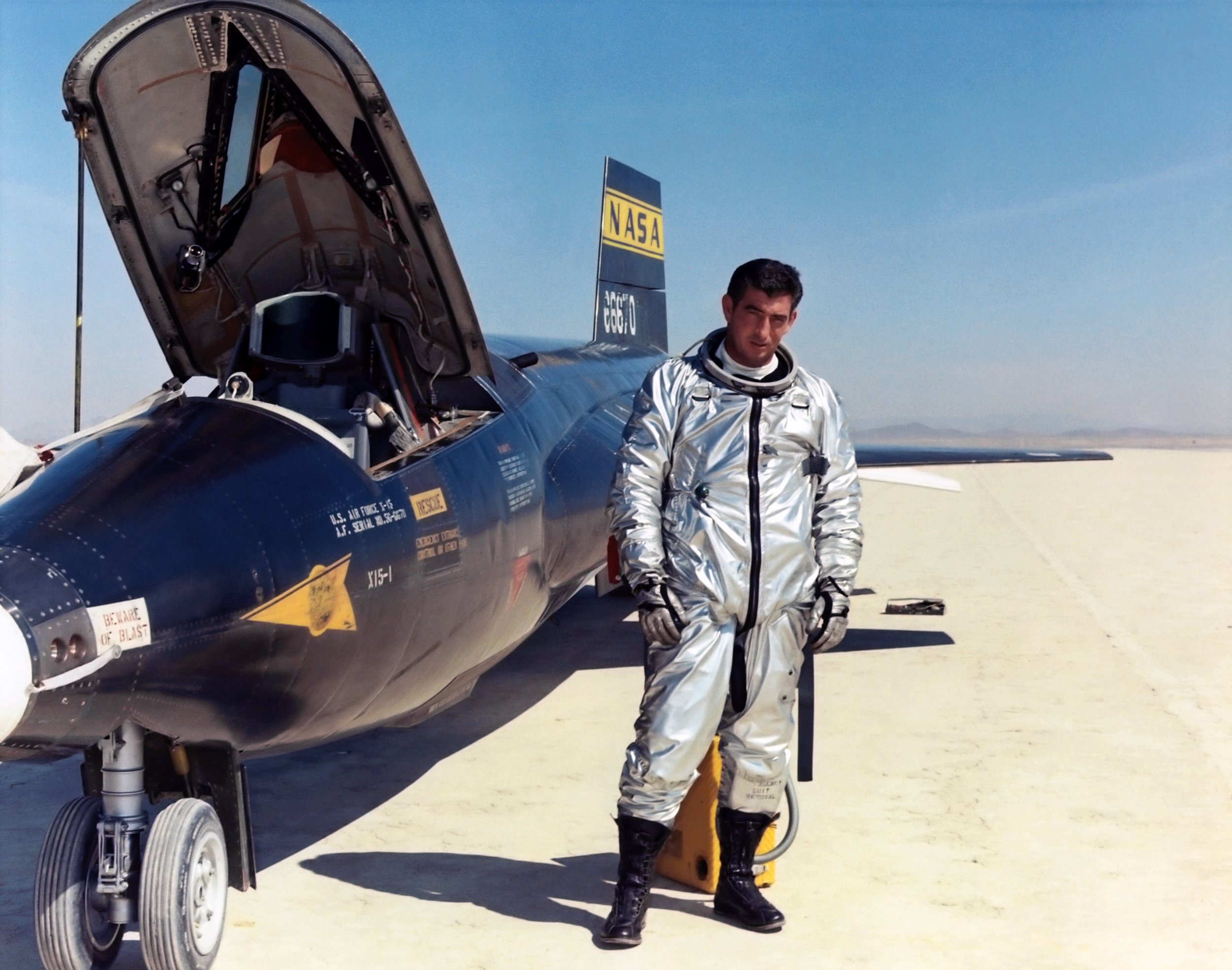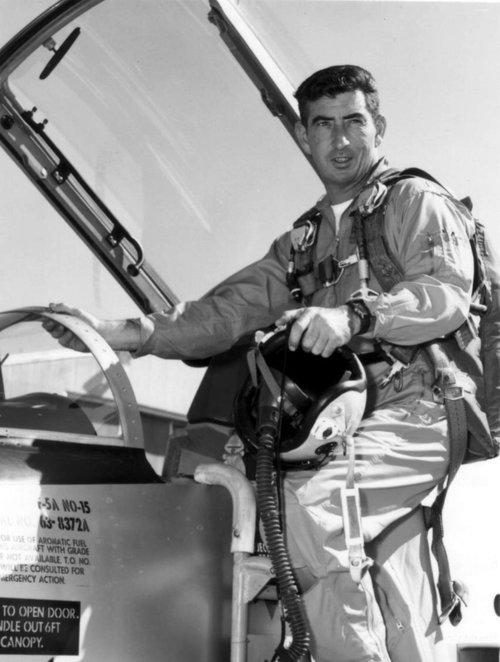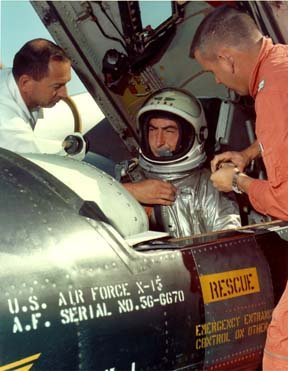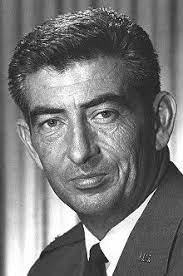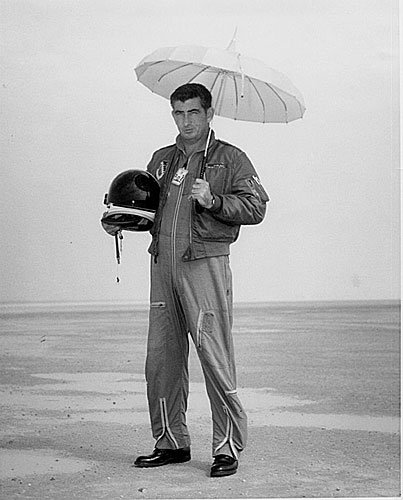Michael J. Adams
Early life and military experience
Adams was born May 5, 1930, in Sacramento, California. He graduated from Sacramento Junior College. He enlisted in the United States Air Force in 1950, and earned his pilot wings and commission in 1952 at Webb Air Force Base, Texas. He served as a fighter-bomber pilot during the Korean War, where he flew 49 combat missions. This was followed by 30 months with the 613th Fighter-Bomber Squadron at England Air Force Base, Louisiana, and six months rotational duty at Chaumont Air Base in France.[2]
Education and flight experience
In 1958, Adams received a Bachelor of Science degree in Aeronautical Engineering from the University of Oklahoma and, after 18 months of astronautics study at Massachusetts Institute of Technology, was selected in 1962 for the U.S. Air Force Test Pilot School at Edwards Air Force Base, California. Here, he won the A.B. Honts Trophy as the best scholar and pilot in his class. Adams subsequently attended the Aerospace Research Pilot School (ARPS), graduating with honors in December 1963. He was one of four Edwards aerospace research pilots to participate in a five-month series of NASA Moon landing practice tests at the Martin Company in Baltimore, Maryland. In November 1965 he was selected to be an astronaut in the United States Air Force Manned Orbiting Laboratory program. In July 1966, Major Adams came to the North American X-15 program, a joint USAF/NASA project. He made his first X-15 flight on October 6, 1966.[2]
Death
Adams's seventh X-15 flight, Flight 3-65-97, took place on November 15, 1967.[3][4] He reached a peak altitude of 266,000 feet (81 km); the nose of the aircraft was off heading by 15 degrees to the right. While descending, at 230,000 feet (70 km) the aircraft encountered rapidly increasing aerodynamic pressure which impinged on the airframe, causing the X-15 to enter a violent Mach 5 spin. As the X-15 neared 65,000 feet (20 km), it was diving at Mach 3.93 and experiencing more than 15 g vertically (positive and negative), and 8 g laterally, which inevitably exceeded the design limits of the aircraft. The aircraft broke up 10 minutes and 35 seconds after launch, killing Adams. The United States Air Force posthumously awarded him Astronaut Wings for his last flight.[citation needed]
An excerpt from NASA's biography page on Mike Adams discusses findings from the crash investigation:
Ground parties scoured the countryside looking for wreckage; critical to the investigation was the film from the cockpit camera. The weekend after the accident, an unofficial FRC (Fleet Readiness Centers) search party found the camera; disappointingly, the film cartridge was nowhere in sight. Engineers theorized that the film cassette, being lighter than the camera, might be further away, blown north by winds at altitude. FRC (Fleet Readiness Centers) engineer Victor Horton organized a search and on 29 November, during the first pass over the area, Willard E. Dives found the cassette. Most puzzling was Adams's complete lack of awareness of major heading deviations in spite of accurately functioning cockpit instrumentation. The accident board concluded that he had allowed the aircraft to deviate as the result of a combination of distraction, misinterpretation of his instrumentation display, and possible vertigo. The electrical disturbance early in the flight degraded the overall effectiveness of the aircraft's control system and further added to pilot workload. The MH-96 adaptive control system then caused the airplane to break up during reentry.[2]
His remains were buried at the Mulhearn Memorial Park Cemetery, Monroe, Ouachita Parish, Louisiana.
Awards and honors
During his military career he was awarded:
Astronaut Wings, posthumously
A.B. Honts Trophy[5]
Adams remembered
In 1991, Adams's name was added to the Space Mirror Memorial at the Kennedy Space Center in Florida.
On June 8, 2004, a memorial monument to Adams was erected near the crash site, northwest of Randsburg, California.[6]
About the X-15
North American X-15, rocket powered experimental aircraft; black titanium skin with wedge shaped horizontal stablizer; yellow stripe NASA inisignia on tail with stars and red bars United States national insignia on wings; white letter text "U.S. AIR FORCE" on the sides of the fuselage.
In the joint X-15 hypersonic research program that NASA conducted with the Air Force, the Navy, and North American Aviation, Inc., the aircraft flew over a period of nearly 10 years and set the world's unofficial speed and altitude records of 4,520 mph (Mach 6.7) and 354,200 feet in a program to investigate all aspects of piloted hypersonic flight. Information gained from the highly successful X-15 program contributed to the development of the Mercury, Gemini, and Apollo piloted spaceflight programs as well as the Space Shuttle program.
Because of the large fuel consumption of its rocket engine, the X-15 was air launched from a B-52 aircraft at about 45,000 feet and speeds upward of 500 mph. Depending on the mission, the rocket engine provided thrust for the first 80 to 120 seconds of flight. The remainder of the normal 8- to 12-minute flight was without power and ended in a 200-mph glide landing. Because the nose landing wheel lacked steering and the main landing gear employed skids, the X-15 had to land on a dry lakebed. The Rogers Dry Lake adjacent to Edwards and Dryden was the intended landing location for all flights, but there were numerous emergency lakebeds selected in advance for emergency landings.

